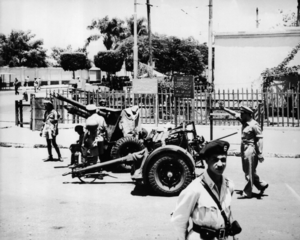Meshir Revolution
This article is incomplete because it is pending further input from participants, or it is a work-in-progress by one author. Please comment on this article's talk page to share your input, comments and questions. Note: To contribute to this article, you may need to seek help from the author(s) of this page. |
| Meshir Revolution | |||||||
|---|---|---|---|---|---|---|---|
 Field guns on the road to Mina in the suburb of St. Mikhail | |||||||
| |||||||
| Belligerents | |||||||
|
Supported by: Template:Country data Estmere |
Supported by: | ||||||
| Commanders and leaders | |||||||
| |||||||
The Meshir Revolution, also known as the February Revolution or February Coup, was carried out by a group of army officers affiliated with the Beheiran Socialist Union against the Beheiran monarchy on 13-14 February 1944. The revolution resulted in the overthrow of the monarchy and the declaration of the Orthodox Council Republic of Djedet with Tawadros Abdelmesseh as president. Emperor Matheos III and Prince Boutros Ghabras were killed during the uprising.
On May 14 1944 a new constitution led to the declaration of a socialist council republic. As president Abdelmesseh launched a socioeconomic program that included land redistribution, agrarian reform, road and railway construction, and a nationwide literacy campaign. The success of the revolution inspired nationalist movements in Bahian countries with active anti-colonial rebellions against Euclean empires.
Background
Beheiran Nationalism

The Meshir Revolution has its roots in the 19th century. In 1879, the Beheiran government defaulted on its foreign debt and declared bankruptcy. Despite this, Gaullica refused to forgive the country's debt and invaded in 1880, seizing half of Beheira's territory and forcing Emperor Tawadros V to declare the country a Gaullican protectorate. The Gaullican invasion galvanized nationalist sentiment. Before, the idea of a "Beheiran nation" was confined to intellectual circles, as national labels such as "Beheiran" and "Makai" did not correspond to any meaningful identity for most. Instead, people primarily defined themselves as belonging to their tribe, town, region, or religious community. It was only after the Gaullican invasion that Beheira saw significant nationalist agitation among the lower and middle classes.
Coming to terms with Catholic rule, Orthodox reformers and secular nationalists drafted their own responses to Gaullican imperialism. Led by Bishop Sarjoun of Dotawo and Mikhail Bestawros, the reformists laid the foundation for the anastasis, a movement that aimed to adapt Southern Orthodoxy to the modern world, calling for a new interpretation of the Bible capable of addressing the challenges of the 19th century. In 1886, Bestawros founded the Orthodox League, a political party that hoped to constrain the power of the emperor through a constitution based on Sotirian principles and present a united front of Bahian Sotirians led by Beheira against Gaullican imperialism.
Bestawros himself was a student of Theodoros Remkone, a cleric at the University of St. Maryam who was in a delegation sent by Emperor Tawadros IV in 1840 to study western science and forms of government in Gaullica. In Overview of Gaullica he observed that Beheira had fallen behind the west in science and technology and that Enlightenment-era ideas had given western states their technological superiority. Following developments in liberal thought and the revolutions of the early 19th century, he became an active proponent of constitutionalism, arguing that a constitution that limited the power of the emperor, promoted the rights of common citizens, and allowed them to attain any office regardless of rank would motivate Beheirans to learn and study the sciences to climb the social ladder. This upward mobility, he believed, would promote innovation and reverse Beheira's technological inferiority. Remkone published Overview of Gaullica when he returned to Beheira in 1848. At the time, Beheira was an autocratic state and Remkone's praise for representative government and constraints on the emperor's power were seen as foreign and subversive by Beheiran elites. Despite this, Remkone's ideas resonated with Bestawros and formed the basis for the politics of the Orthodox League and other constitutionalist parties.
Meanwhile, the spread of the printing press and the telegraph led to a literary revival known as the nahda. Intellectuals from Mina to Souan were actively writing books on Beheiran history and culture and commentaries on classical works of Beheiran literature. The nahda was a moment of cultural definition and rediscovery and laid the foundation for Beheiran nationalism. In 1892, Abassad Beshada and Harun Remtanthanos founded the Nahda Party. Beshada and Remtanthanos agreed with the constitutionalism of the Orthodox League but rejected its pan-Sotirian ambitions. In al-Sawt, the party newspaper, Beshada argued that Beheira was a direct descendant of Ancient Djedet and that the Beheirans and Makai were a nation united by a common history, culture, and religion. al-Sawt and other newspapers provided the nascent nationalist movement with broad support among students and intellectuals. By the beginning of the 20th century, Nahda, followed by the Orthodox League, was the largest political party in the country.